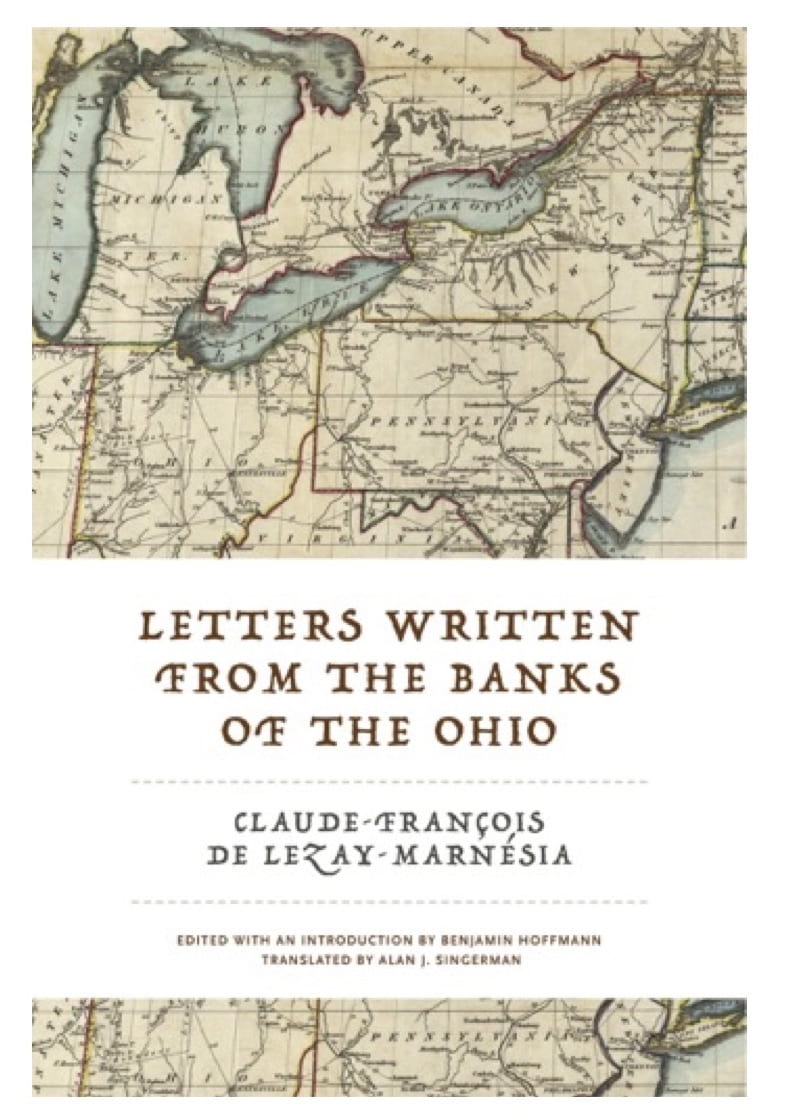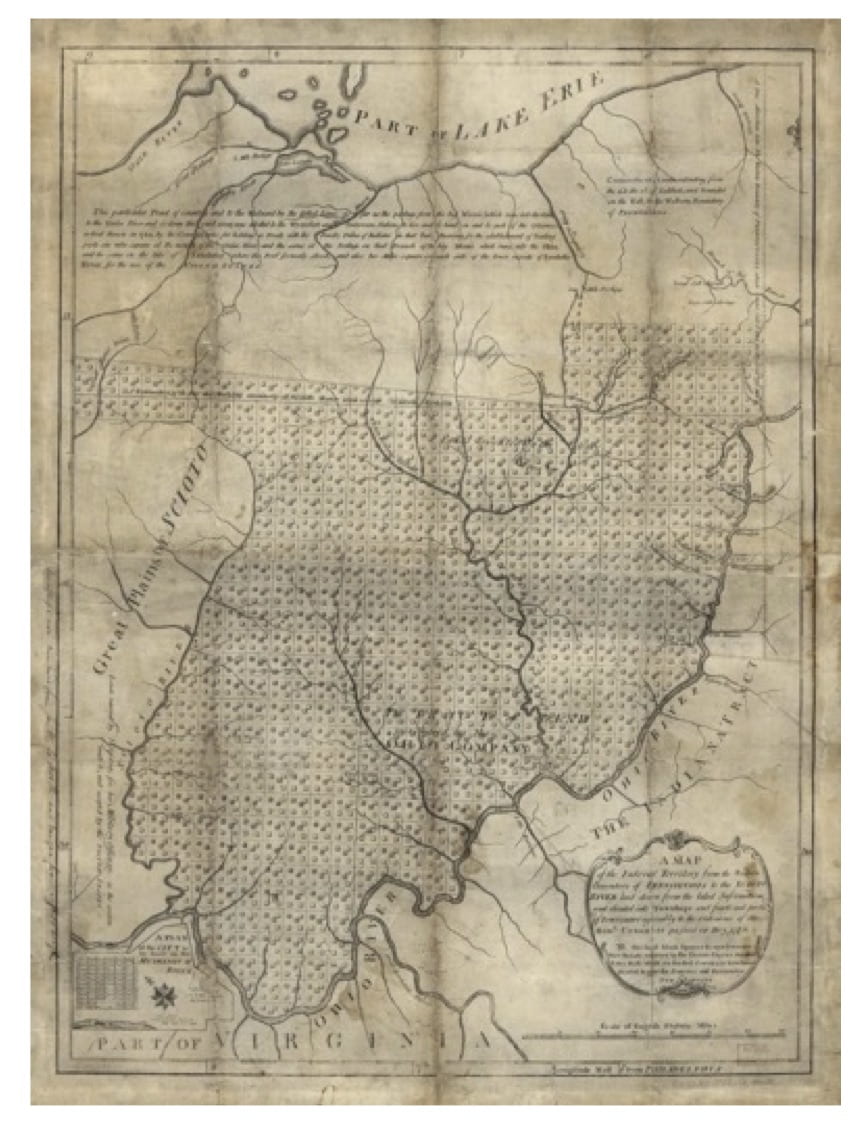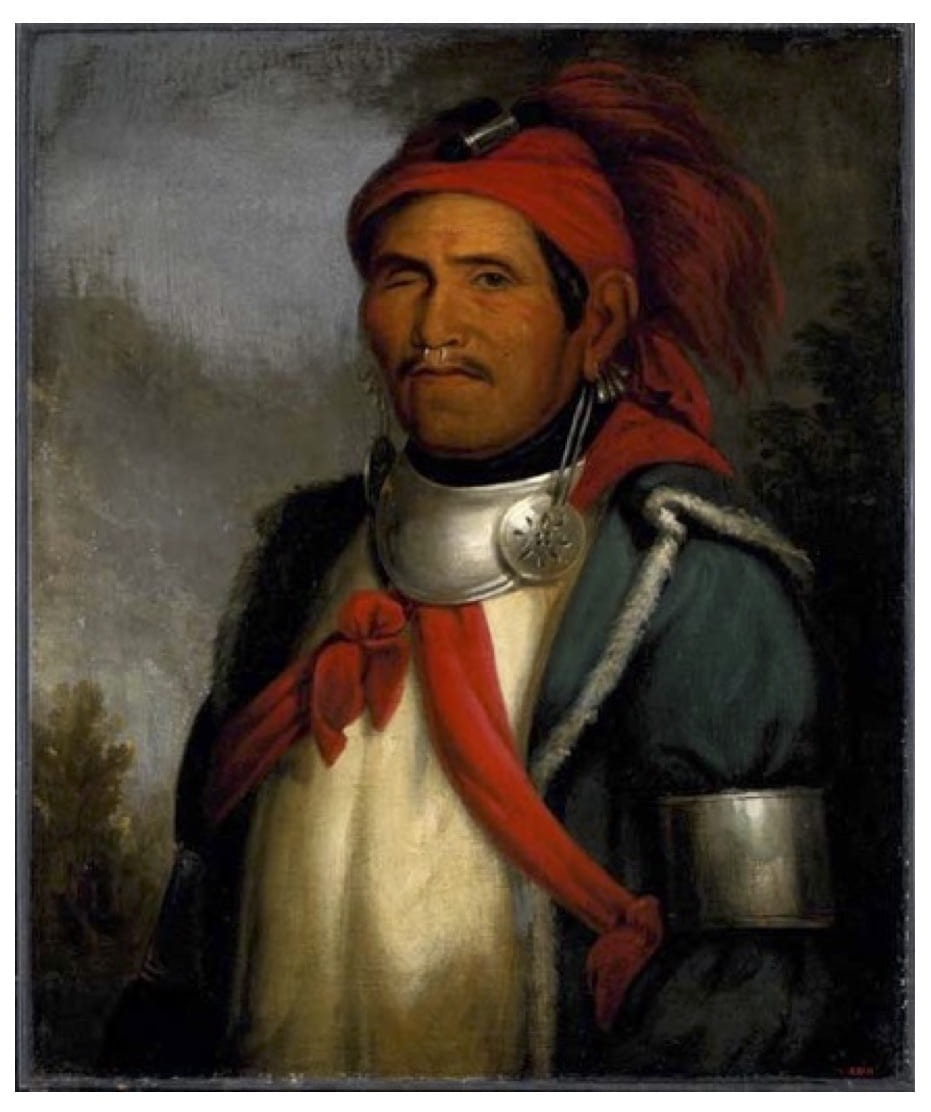A Conversation with Benjamin Hoffmann, Assistant Professor of Early Modern French Studies at The Ohio State University and editor of a new edition of the Letters Written from the Banks of the Ohio by Claude-François-Adrien de Lezay-Marnésia (Pennsylvania State University Press, translated by Alan J. Singerman, 2017)
In 1790, Claude-François-Adrien de Lezay-Marnésia left France to found a colony on the Scioto River, a tributary of the Ohio in the Northwest Territory. Yet by 1792, he had fled, his fortune squandered and his grandiose plans for an aristocratic utopia unrealized. This new edition of his letters, penned in 1790 and 1791, reveals a man purposefully, somewhat pathetically, imagining a pastoral idyll in the Old Northwest as the realities of the Ohio Country increasingly resisted his vision.
His letters, as Benjamin Hoffmann explains, can be read as a bridge between two very
well-known French texts about North America: Crèvecœur’s 1789 Letters from an America Farmer and Tocqueville’s Democracy in America (1835-1840). Together, they trace a literary evolution of the United States in French thought from a clean slate of possibility to an uncivilized, capitalist, and deeply flawed republic.
What follows is part of my conversation with Hoffmann on the themes of Lezay-Marnésia as a tragic figure, fantasy and colonization, and competing imaginaries of the Ohio Valley.
Julia: What made you want to edit and re-publish this volume?
Benjamin: This project started in 2011, as I was undertaking my doctoral dissertation at Yale. Being French in the United States, I wanted to investigate the representations of America in French Literature during the eighteenth century. The problem I immediately encountered was the extreme abundance of materials: dozens of travel narratives were written by French people about North America during the age of the enlightenment. Unfortunately, in too many cases, they are not very artfully written, and they present at best a documentary interest. Consequently, while it was easy to find texts fitting in the category of “French representations of America written between 1700 and 1800”, few writers transformed their experience in the New World into a genuine work of art. The Lettres écrites des rives de l’Ohio struck me because they are an exception to this rule. First, they are the work of a mature writer, a man who was in his late fifties when he published them, after spending most of his adult life reading the work of fellow philosophers and building his own œuvre. Indeed, Lezay-Marnésia was a talented polygraph, the author of philosophical essays, poems, short-stories, translations, even works on mineralogy. In 1790, when he traveled to the United States, he had already a long intellectual career behind him. Moreover, his Letters Written from the Banks of the Ohio pursue a dialogue with Montesquieu, Fénelon, Saint-Pierre, and Rousseau by making numerous references to their works and asking a question they all spent a great deal of time meditating: what makes a perfect society and how can you create one in the real world rather than just imagining it? This intellectual dialogue plays a major part in the literary and philosophical richness of Lezay-Marnésia’s volume, which is a late reinterpretation of some of the major preoccupations of the French enlightenment. A question immediately comes to mind after reading the story of Lezay-Marnésia’s emigration to the Northwest territory: his journey was a complete failure, a true disaster, he lost most of his fortune, two years of his life, and finally decided to go back to France at the most dangerous moment for an aristocrat, just before the terreur. And yet, despite all his hardships, Lezay-Marnésia keeps describing the Scioto region and western Pennsylvania as a true paradise, a sort of lost Eden he deeply regrets having left.
Julia: Why did French émigrés like Lezay-Marnésia choose the Northwest Territory instead of culturally “French” places in North America, like Spanish Louisiana or British Quebec?
Benjamin: Lezay-Marnésia and his compatriots chose the Northwest Territory based on false assumptions. The most important one was the assumption that it was an empty space. Indeed, we have to realize that the Northwest Territory had just been surveyed, and that very little was known about it in Europe. When Lezay-Marnésia bought lands in this region, he only knew what the Scioto Company told him about it, and most of the information he received turned out to be misleading at best, and at times completely dishonest. For example, the Scioto Company failed to mention the presence of Native American tribes in the region: in the several documents provided by the Scioto Company to its clients, Amerindians are not mentioned a single time, whereas they turned out to be the biggest challenge French settlers were going to meet in their attempt to create a colony. Consequently, the Scioto Company slyly conveyed the idea that the Northwest Territory was a clean slate where its clients would be able to organize themselves the way they wanted to, by adopting the rules and the social organization they desired. That was especially appealing for Lezay-Marnésia and his partners of the Society of the Twenty-Four, who thought an ideal French society could be realized in this isolated space: a society that would retain some of the basic structural elements of the Old Regime (especially, a strong hierarchical divide between social classes), while creating a new kind of social contract, based on philanthropy. That’s why the Scioto region had advantages over other potential spaces of emigration, such as Spanish Louisiana and British Quebec: it was more than just a space to temporarily settle and wait until the end of the Revolution before going back to France; it was seen as a permanent settlement, close enough to trade with the United States, but far away enough to create an independent society on a territory that was not yet an official part of the Union. Moreover, the land was quite affordable for French people, and a lot was for sale: if the least well-off buyers acquired only several acres, the richest ones bought thousands (Lezay-Marnésia acquired no less than twenty thousand acres!). Very astutely, the Scioto Company played with the fears of French people who were witnessing the first events of the Revolution, while offering them at an extremely competitive price a quantity of land none of them would have been able to buy in their homeland.

A map of the Federal Territory from the western boundary of Pennsylvania to the Scioto River, Manasseh Cutler, 1788. Library of Congress Geography and Map Division. This 1788 map shows imagined townships and township subdivisions between the Ohio and Scioto Rivers, where the Ohio Company had purchased pre-emption rights. Lezay-Marnésia and his associates in France bought parts of these pre-emption rights under the false impression that they were complete ownership rights.
Julia: Lezay-Marnésia’s vision for his Scioto colony is one in which hardworking settlers are “careful to include Indians among them” (69). His pointed insistence on their inclusion – based on an imagined racial hierarchy and an expectation that Native Americans would adopt European customs – strikes me as bittersweetly naïve, especially given the incredible violence between whites and Native Americans in the Ohio Country in this era. Do you read Lezay-Marnésia’s inclusion of Native Americans as a response to this cultural climate (however impractical), or does it just further betray his disconnection from reality on the ground?
Benjamin: I believe it betrays his disconnection from reality. Indeed, Lezay-Marnésia knew very little about America before deciding to emigrate to the Scioto region, and the little he knew was taken from his reading of the Lettres d’un cultivateur américain by Saint-John de Crèvecœur, a work very much influenced by Rousseau, where Native American are depicted as “bons sauvages”, living in perfect harmony with white settlers. I think it’s difficult to overestimate the influence of the concepts of “noble savages” and “state of nature” on the writings of eighteenth-century novelists and philosophers such as Crèvecœur, Lezay-Marnésia, but also Brissot, Bernardin de Saint-Pierre, and so many others. Rousseau used these concepts as thought experiments, as theoretical artifacts, in order to imagine what happened before the creation of complex human societies. But these concepts became so wildly popular that they ceased to be used the way Rousseau intended to employ them: they were taken more and more literally, as if they were describing real people, living at a prelapsarian state that one could still witness outside Europe, something believed by Bougainville and other French explorers. Lezay-Marnésia is a striking example of these disciples of Rousseau who outlived their master and saw the world through the mediation of his works. What fascinates me is the fact he did not try to communicate this troubling experience of alterity, but insisted on representing Native Americans the way he imagined them when he was still in France. Traveling, in a way, was completely useless: in his case, it did not change who he was or what he thought he knew, he even had to forget about it to repeat what he would have said if he had stayed at home. I read this phenomenon as one of the many indications of the therapeutic nature of his literary work: representing things and people as you wish they were, instead of the way you know they are, is a way to come to terms with the almost unbearable disappointments you can experiment. It also proves the outstanding power of literature, that becomes a tool to create an alternative reality corresponding to your wishes and hopes. But when you drop the quill, you have to face reality: that’s why the third of the Letters Written from the Banks of the Ohio is so long, because Lezay-Marnésia cannot bear to stop writing, which would break the spell, so he keeps describing these quite absurd (and at the same time, quite beautiful) scenes of rural banquets, where Native Americans, rich and poor settlers alike, all share a moment of common happiness, enjoying together the beauty of nature and the prosperity of their colony. Of course, this is a pure fantasy, where the point of view of the Amerindians is absolutely not taken into consideration. Lezay-Marnésia just assumes they will be kind and obedient subjects. But I think it’s an illusion he cultivated while he was writing, because it was just too hard for him to accept that he had spent nearly the totality of his once gigantic fortune, risked his life, left at home his wife and two of his children, and spent so much energy, before heading back to France, ruined and bitter. Consequently, this disconnection from reality is in a way self-induced: it’s not madness, or stupidity, it has more to do with finding a way to grieve a world he did not manage to create.
Julia: In addition to a white settler fantasy in which Native Americans had been exterminated, Lezay-Marnésia’s Ohio utopia made me think of the Native American prophets Neolin (Lenape), and later, Tenskwatawa (Shawnee), who also imagined a possible world in the Ohio Country, in which Native Americans would achieve a purified unity through their rejection of European culture and lifeways. Unlike Lezay-Marnésia’s, theirs were distinctively exclusive visions in which settlers and Native Americans could not and would not co-exist. What does it mean to consider Lezay-Marnésia’s utopian Aigle-Lys not just as part of a genre of French visions of the U.S., but as one of several competing imaginaries about the same place? His certainly co-existed in the Ohio Country with a white settler fantasy in which Native Americans have been exterminated, and a prophetic Native American vision in which whites have been expelled and their culture rejected. We might want to explain Lezay-Marnésia’s penchant for fantasy as a result of his being a distant émigré, but what if those much closer to the ground also saw Scioto as an imaginary space?
Benjamin: Not only can we read Lezay-Marnésia’s utopia as part of several competing imaginary appropriations of this land, but also as one of many competing geopolitical projects. Indeed, the vast territory where he wanted to build Aigle-Lys was coveted by several super-powers at the end of the eighteenth century. Great Britain still held several key military positions in the region; Native American tribes fought to keep the control on their ancestral lands, in particular the Miamis and the Shawnees; the American government was planning the westward expansion of the United States; even the French government had views on this place, since the Girondins aimed to create sister-republics in the region, sharing political and commercial interests with France. So, there was a fierce competition, not only of imaginaries as you observed, but also of power and political projects. To comment on this phenomenon, I would venture two possible explanations. The obvious one has to do with a sense of opportunity: the political status of this region was still uncertain, and to ambitious powers, it looked as a place free for the taking. Let’s not forget that France, just a few years later, when it got back Louisiana from Spain thanks to the treaty of San Ildefonso (1800), for a moment imagined to recreate its empire in North America. We know how things turned out – the purchase of Louisiana in 1801 definitely put an end to this dream – but for the contemporaries, there was still the sense that what we know would become part of the United States, could still belong to a European power. But there is another explanation that has to do with the specificity of the landscape, I think. This region, especially Ohio, is very flat: in a way, it is a sort of natural embodiment of the concept of the “clean slate”, a vast space, where anything is possible, where utopias can freely flourish. It has an idyllic aspect in many places, and, precisely, the comparison between the Ohio region and the garden of Eden was repeated by several French writers, including Crèvecœur and Lezay-Marnésia. It is as if the Ohio landscape was a kind of canvas where the boldest imaginations of the human mind could be projected while simultaneously leading to an association with very ancient fantasies, such as the dream of recreating the golden age. For Lezay-Marnésia, there was certainly no limit to what he thought possible: he imagined Aigle-Lys – even if he never articulates the political relation of this growing colony with the American government – as the center of a future empire, an empire he compares to a hive sending its swarms to colonize the almost boundless American space…

Tenskwatawa (The Prophet) 1768-1837, by Henry Inman (1801-1846), after Charles Bird King, c. 1830-1833. National Portrait Gallery, Smithsonian Institution
Julia: By way of concluding, I’d like to push this final point on the inclusion of Native American visions of the Ohio Valley a bit further. As Gregory Dowd demonstrates so well in A Spirited Resistance, broadly accepted ideas for Native self-determination and resistance—often based in theories of separate creation between Euro-Americans and Native Americans—proliferated throughout the Old Northwest from the 1760s on ( Gregory E. Dowd, “Thinking and Believing: Nativism and Unity in the Ages of Pontiac and Tecumseh,” American Indian Quarterly 16, no. 3 (1992): 309–350). Spiritual theories fused with political action in the form of, for example, the Shawnee prophet Tenskwatawa’s 1806 invitation to all Indian peoples to join him in settling the town of Greenville, Ohio. This imagined community forms an intriguing counterpoint to Lezay-Marnésia’s own planned town (ibid., 312). In reading Dowd’s writing about Tenskwatawa and his brother Tecumseh’s visions for the Ohio Country, I found that your characterization of it as a place that feels both ancient and full of potential possibility seems to fit very appropriately into what they hoped for and preached of. More generally, I’d also propose that including Native Americans as visionaries may allow a broader and more complex picture of these connections between fantasy, politics, and place to emerge. It frames Native Americans as more than reactive defenders of ancestral territories who didn’t have the power or luxury to transcend pragmatism.
The third competing imaginary for the Old Northwest during this era was, of course, the United States project of imposing the Public Lands Survey System grid. The Ohio Valley was the first place that the U.S. tried out this attempt at regular, linear township squares, and they often appeared on maps long before they appeared on the ground. Thus, the 1788 map of neatly delineated townships squares represented an imagined future, not a present reality.
In an important sense, all three projects—Lezay-Marnésia’s Aigle-Lys, Tenskwatawa’s Greenville, and the PLSS.—these were all imaginative projects involving an element of fantasy, but they also represented very real geo-political designs. Lezay-Marnésia’s might seem the most fantastical because it failed so spectacularly, but even though the United States project of imposing the PLSS succeeded didn’t make it necessarily less imaginary in its nascent stage. For Tecumseh and Tenskwatawa, whose visions of the Old Northwest also met with failure, the power of fantasy and the reality of defending and protecting land were intimately intertwined. Can we ever draw clean conceptual lines between geopolitical contests and imaginative visions?
Julia Lewandoski is a doctoral student at the University of California, Berkeley. Her dissertation considers the impact of imperial transitions on indigenous landholding in eighteenth and nineteenth-century Quebec, Louisiana, and California.



Leave a Reply